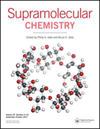Chromogenic detection of fluoride, dihydrogen phosphate, and arsenite anions based on 2,4-dinitrophenyl hydrazine receptors: spectral and electrochemical study
IF 2.6
4区 化学
Q3 CHEMISTRY, MULTIDISCIPLINARY
引用次数: 0
Abstract
ABSTRACT The colorimetric recognition of biologically relevant fluoride (F−), acetate (AcO−), and dihydrogen phosphate (H2PO4 −) ions, and poisonous arsenite (AsO2 −) ions, was devised and new receptors for these anions synthesised via the Schiff base condensation procedure. UV–visible titration, fluorescence titration, 1H-NMR titration, and cyclic voltammetry were used to explore the interactions of receptors R1–R3 with anions and possible detection mechanisms. The synthesised probes could sense inorganic fluoride, acetate, dihydrogen phosphate, and arsenite in the organo–aqueous medium (H2O/ Dimethylsulphoxide, 1: 9, v/v) and displayed a change in colour detectable to the naked eye. Out of the three synthesised receptors, receptor R1 showed better sensing ability of fluoride, acetate, dihydrogen phosphate, and arsenite ions in the organo–aqueous medium with a lower detection limit of 0.1 ppm, 0.171 ppm, 0.194 ppm, and 0.144 ppm, respectively. All three receptors formed complexes with the anions through H-bonding interaction followed by deprotonation of the NH proton. Graphical Abstract基于2,4-二硝基苯肼受体的氟化物、磷酸二氢和亚砷酸阴离子的显色检测:光谱和电化学研究
设计了与生物相关的氟(F−)、醋酸(AcO−)、磷酸二氢(H2PO4−)离子和有毒的亚砷酸盐(AsO2−)离子的比色识别方法,并通过希夫碱缩合法合成了这些阴离子的新受体。采用紫外可见滴定法、荧光滴定法、1H-NMR滴定法和循环伏安法研究了受体R1-R3与阴离子的相互作用及其可能的检测机制。合成的探针可以检测有机水介质(H2O/二甲基亚砜,1:9,v/v)中的无机氟化物、醋酸盐、磷酸二氢和亚砷酸盐,并显示肉眼可检测的颜色变化。其中,受体R1在有机水介质中对氟、醋酸、磷酸二氢和亚砷酸盐离子的检测能力较好,检出限分别为0.1 ppm、0.171 ppm、0.194 ppm和0.144 ppm。所有三种受体通过氢键相互作用与阴离子形成配合物,然后是NH质子的去质子化。图形抽象
本文章由计算机程序翻译,如有差异,请以英文原文为准。
求助全文
约1分钟内获得全文
求助全文
来源期刊

Supramolecular Chemistry
化学-化学综合
CiteScore
3.60
自引率
3.00%
发文量
5
审稿时长
2.7 months
期刊介绍:
Supramolecular Chemistry welcomes manuscripts from the fields and sub-disciplines related to supramolecular chemistry and non-covalent interactions. From host-guest chemistry, self-assembly and systems chemistry, through materials chemistry and biochemical systems, we interpret supramolecular chemistry in the broadest possible sense. Interdisciplinary manuscripts are particularly encouraged. Manuscript types include: high priority communications; full papers; reviews, and; Methods papers, techniques tutorials highlighting procedures and technologies that are important to the field. We aim to publish papers in a timely fashion and as soon as a paper has been accepted and typeset it will be published in electronic form on the Latest articles section of the website. The two most important review criteria are that the paper presents high-quality work that fits generally into the broad spectrum of activities in the supramolecular chemistry field. Under normal circumstances, Supramolecular Chemistry does not consider manuscripts that would be more suitable in a highly specialized journal. This includes, but is not limited to, those based mostly or exclusively on topics such as solid state/X-ray structures, computational chemistry, or electrochemistry. .
The two most important review criteria are that the paper presents high-quality work that fits generally into the broad spectrum of activities in the supramolecular chemistry field.
 求助内容:
求助内容: 应助结果提醒方式:
应助结果提醒方式:


